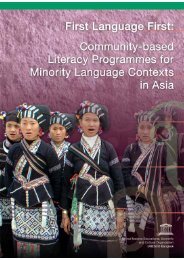Part II.pdf - MTB-MLE Network
Part II.pdf - MTB-MLE Network
Part II.pdf - MTB-MLE Network
You also want an ePaper? Increase the reach of your titles
YUMPU automatically turns print PDFs into web optimized ePapers that Google loves.
• The content of the materials was relevant to the learners.<br />
• Villagers supported and participated in material production. They were interviewed,<br />
requested to tell stories and helped edit the materials. They were empowered through<br />
the bilingual literacy project.<br />
7. Challenges of the Project and Possible Solutions<br />
This is the first year of the pilot project. We attained the main objective which was to develop<br />
bilingual literacy materials. If we consider it as a ‘Learning Project’ for the facilitators, there were<br />
many lessons learned. However, there are some challenges and potential solutions:<br />
Project administration: There are a number of NFE personnel involved in the project, from the<br />
Central NFE office, Bangkok; Regional NFE centre, Lampang Province; Chiang Mai NFE provincial<br />
centre; Omkoi NFE district; and Nong Ung Tai Community Learning Centre. It is almost<br />
1,000 km from Bangkok to the village site. Such a long distance effects working together as<br />
a ‘research team.’ Besides the difficulty in travelling, there is also difficulty in communication<br />
with each other, whether by telephone or letter. Sometimes, contact is lost.<br />
Bilingual approach is very new to NFE: The aim of the literacy programme is actually to teach<br />
people to read and write in the Thai national language. When the bilingual literacy programme<br />
was introduced, we were reluctant to implement this new approach. Many questions arose that<br />
could not be immediately answered. (Is it an effective approach of literacy programme How<br />
long does it take to build the literature bridge Who is going to do what and how)<br />
Sustainability of the project: Even though Pwo villagers were involved in the project from the<br />
beginning, some questions still arose. For example, why do they have to learn their own language<br />
when they have not had a Pwo writing system for more than 200 years It’s challenging to see<br />
how the project can be sustainable, and what factors will make it so.<br />
The development of a literacy programme is not an easy task. It takes greater effort to run the<br />
project because of the target group’s constraints. The bilingual project is more difficult because it<br />
was necessary to begin with developing a writing system. In addition, there is a paradigm shift<br />
from “making for” to “making with” the people. This is more challenging.<br />
8. Future plans<br />
Facilitators/Teacher training<br />
There are now four Pwo Karen teachers (3 are CLC NFE teachers working for 2 CLCs and the<br />
other is a cross-area supervisor). Through discussion and agreement of the teachers with the Director<br />
of Omkoi NFE District, one Pwo teacher will work for each CLC from now on. So there are three<br />
CLCs working with the bilingual literacy programme. The project plans to train about four more<br />
Pwo Karen teachers in Omkoi district to work with this approach.<br />
In addition to the teachers, there are a group of six out-of school youth – both male and female.<br />
They have been actively involved in the project from the beginning. This group of Nong Ung Tai<br />
210
















